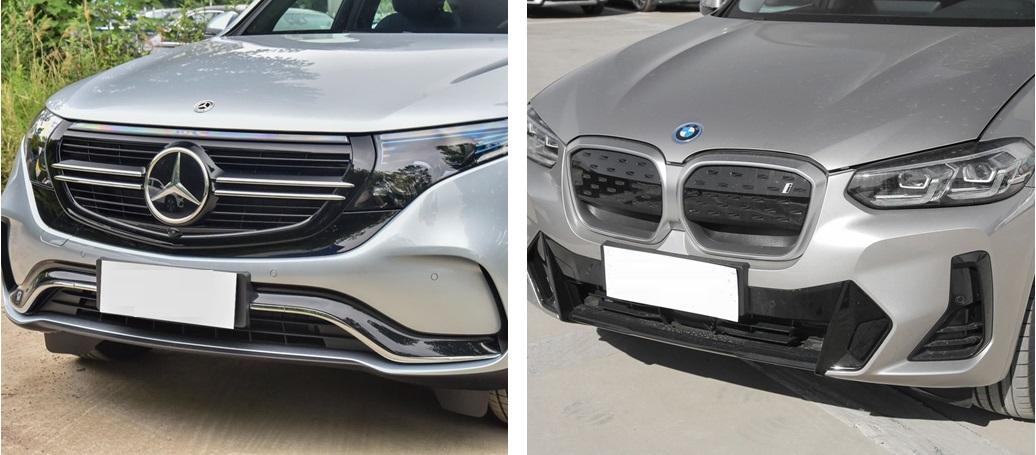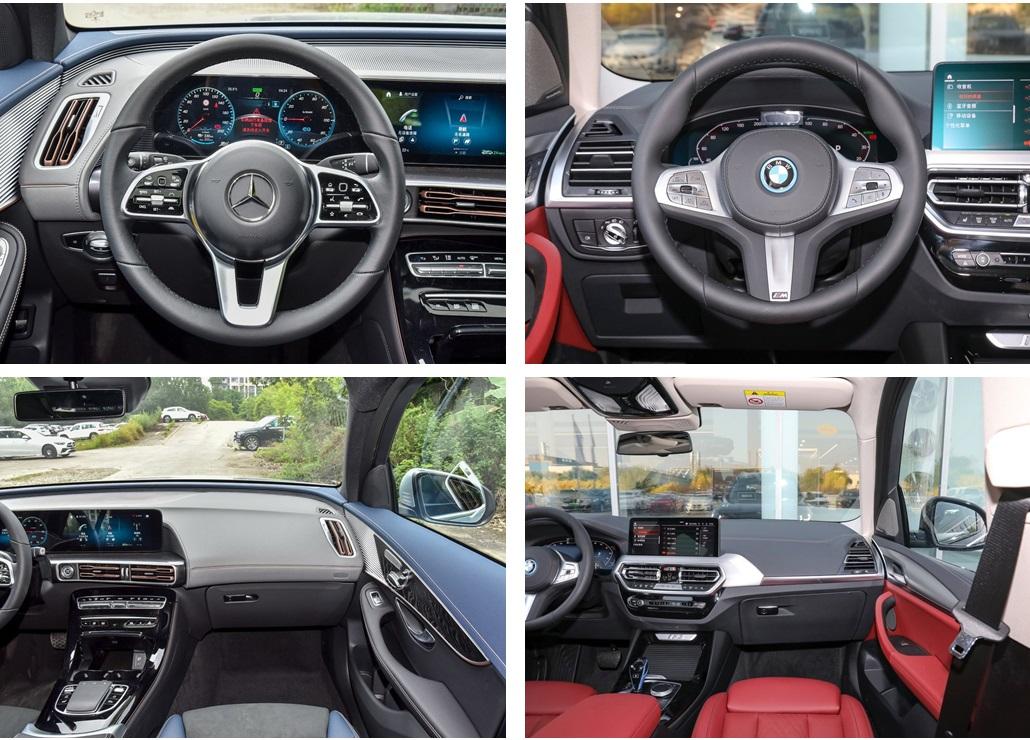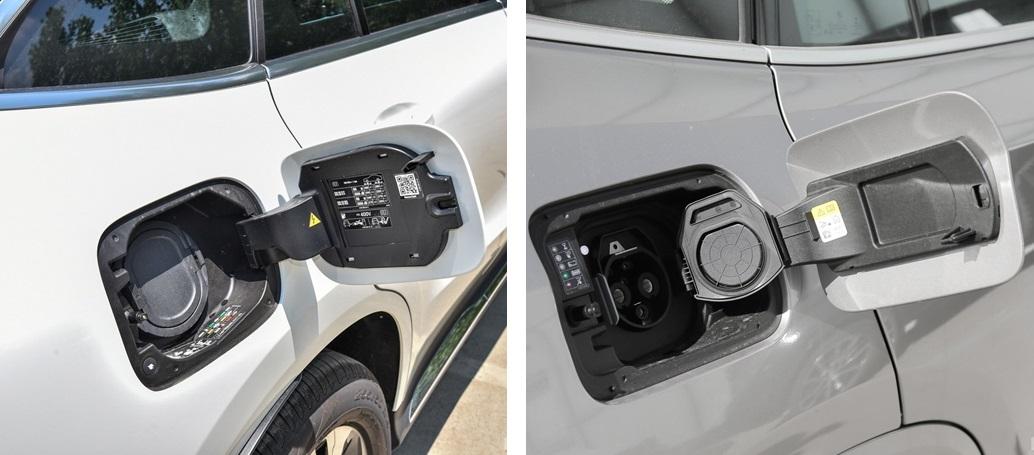In recent years, with the continuous implementation of car electrification, the domestic new energy vehicles also ushered in rapid development, and in addition to the rise of new power brands such as "WEY, Xpeng and LI", traditional luxury car brands have also started to make efforts, and emerged many high-quality models. BMW iX3 is one of them, it is BMW's first mass-produced pure electric SUV, the car has been favored by many consumers since its launch with excellent quality performance and precise market positioning, but it belongs to the same competitor Mercedes-Benz EQC, is also eye-catching. So the same luxury medium-sized pure electric SUV, Mercedes-Benz EQC and BMW iX3 how to choose it? Next let us start from the details to understand the differences between them specifically.

Does the technological design fit the positioning of a luxury SUV?
In terms of appearance, both models adopt the latest family design language, the overall shape of the minimalist yet sporty and technological sense. In the front part, the Mercedes-Benz EQC adopts a closed "shield" front grille design, which is complemented by horizontal spokes and large logo design, presenting a good sense of refinement. The headlight cluster is designed in a chic way, with the EQ' s exclusive Ring of Time running through the light band, which is recognizable when lit up at night. The "X" shape of the front surround is recessed on both sides, creating a good sense of style, while the trapezoid-shaped air deflector on the bottom can effectively clear the airflow under the car.
The BMW iX3 has a unique semi-closed "double kidney" front grille design with dotted elements and blue outline trim inside, presenting a good sense of science fiction. The headlight cluster is sharply shaped, with a simple and slim internal light band shape, and a strong sense of design. The front surround adopts a large number of folding design, looks very aggressive, both sides of the air intake into the longitudinal "L" type blue exclusive design, like a fang, very visual impact.
The "double waistline" with concave design makes the whole side of the body more full, and the silver-rimmed window frame with large sports wheel design further enhances the overall quality of the car. The rear part of both models echoes the front. The rear of the Mercedes-Benz EQC is more spacious, and the taillight cluster adopts a more mainstream through design, with the chrome trim strip at the bottom of the rear surround, presenting a good sense of hierarchy. The rear of the BMW iX3 is angular, with a three-dimensional suspension design for the taillight clusters and a smoked finish, with vertical rear side surrounds, blue spoilers and gray trim at the bottom to further enhance the sporting effect of the rear.
The interior design of both models is relatively atmospheric and trendy, and the overall layout is simple and stylish without losing the sense of technology. The central control part, both adopt asymmetric "T-shaped" layout, dark theme with silver chrome decoration, showing a good sense of texture, the traditional air conditioning vents are retained below some physical buttons, the operation is relatively easy. In terms of technology configuration, both models have a mainstream level of performance, the Mercedes-Benz EQC has a stronger sense of design, with a 10.25-inch full LCD instrument panel and 10.25-inch touchscreen dual screen design, while the BMW iX3 has a better sense of technology, with a 12.3-inch full LCD instrument panel and 12.3-inch suspended center screen design.
In terms of workmanship and materials, the center console is covered with a large area of soft materials, and supplemented with stitching design to enhance the interior. The steering wheel is equipped with a three-spoke round bottom design, and the material is also very sincere, with a leather multi-function steering wheel as standard. The black interior of the Mercedes-Benz EQC is more elegant, while the black/blue interior is more dynamic. The BMW iX3 is designed with a dual color scheme, with the black/mocha interior being more homely and the black/volcanic red interior being more stylish.
In terms of space, both models are located in the medium-sized SUV, the Mercedes-Benz EQC' s length, width and height are 4774mm/1890mm (1923mm for the top) /1622mm, with a wheelbase of 2873mm, the BMW iX3's length, width and height are 4746mm/1891mm/1683mm, with a wheelbase of 2864mm, from the body size alone, the two models are The length and wheelbase of the Mercedes-Benz EQC are slightly longer, while the height of the BMW iX3 is higher. In terms of riding space, the front row space is relatively generous, 174cm tall experience into the front seats, there is no sense of oppression, but the height of the BMW iX3, the BMW iX3, the head space is more adequate, can reach a fist a finger or so. Rear space is also more than adequate, but the length and wheelbase of the superior Mercedes-Benz EQC to be slightly more generous, its head space can reach a fist of about two fingers, leg space also has about two fists and two fingers.
Interior: as mid-size luxury electric SUVs, are Mercedes-Benz and BMW spacious enough?

In terms of storage space, both models are well equipped, such as the more conventional front door panel storage slots, rear door panel storage slots, passenger side glove box, front/rear central armrest and cup holders, etc. The interior mirror control area of the Mercedes-Benz EQC and the left side of the BMW iX3 are also equipped with additional storage compartments under the air conditioning vents. In terms of luggage compartment, both models are equipped with an electric rear tailgate with memory function, and both have large openings and a relatively flat interior layout. The regular volume of the Mercedes-Benz EQC is 500L, and the regular volume of the BMW iX3 is 510L, which can be expanded to 1560L with the rear seats down.
In terms of riding experience, both cars adopt the "2+3" conventional seating layout, with the Mercedes-Benz EQC using leather seats and the BMW iX3 faux leather seats, the former having a better performance in terms of texture. In the front seats, the internal padding of both models is relatively full and supportive, and the wings on both sides of the cushion and both sides of the backrest are relatively prominent and have good wrapping. Rear seat part, both sides of the seat cushion are relatively wide, soft hardness is also relatively moderate, the front of the cushion are slightly elevated, the leg support is more adequate, but the middle cushion internal padding is slightly thin, comfort is slightly worse than the two sides, and Mercedes-Benz EQC middle cushion is also somewhat short, for passengers with long legs, the support may not be sufficient.
The front seats are electrically adjustable and heated. The BMW iX3 is equipped with memory function (driver) as standard, while the Mercedes EQC is equipped with memory function (driver) only in the top model, but its top model can be equipped with massage function as an option. The driver's seat is equipped with headrest adjustment, lumbar adjustment and legrest, the passenger seat also supports headrest adjustment and legrest, while the Mercedes-Benz EQC also supports lumbar adjustment. The rear seats are slightly more conventional, except for the headrest adjustment, the Mercedes EQC can also be equipped with optional heating function, while the BMW iX3 has more backrest angle adjustment
In terms of intelligent connectivity, both models are equipped with hardware that is very sincere, the Mercedes-Benz EQC is equipped with a dual-link screen with an integrated design, the overall sense of excellence, the screen in black as the theme, the dashboard interface uses a more traditional pointer-type double-circle design, the UI interface of the central control screen is relatively simple and fresh, the touch is delicate and flexible, sensitivity is also good, but its screen is surrounded by a relatively wide bezel design. If it can be optimized again, its overall aesthetics should be better. The BMW iX3 is equipped with a 12.3-inch instrument panel and center screen as standard, with a strong sense of technology. Both screens have a dark theme, and the instrument panel interface on the left side has a more mainstream digital fan design, while the UI interface layout of the center screen is relatively traditional, with the toolbar located on the left side of the screen, making it easy for the driver to operate.
In the software part, both models also perform well. In addition to supporting conventional functions such as intelligent voice, multimedia entertainment, in-car online services and vehicle control, the MBUX car system on the Mercedes-Benz EQC also supports voice interruption, simple conversation, mouth instead of hand and voice map navigation, while the iDrive 7.0 human-computer interaction system on the BMW iX3 can also support gesture recognition, Intelligent voice assistant, iPhone unlocking car, parking map navigation and other digital functions. In terms of vehicle control, the Mercedes-Benz EQC's cell phone APP supports door control, air conditioning control, vehicle condition inquiry/diagnosis and vehicle location/tracking services, while the BMW iX3's cell phone APP is more functional and also supports personalized owner services such as vehicle start-up, charging management and maintenance/repair appointments. In terms of other features, both models are well-equipped, like GPS navigation system, navigation road information display, roadside assistance service, Bluetooth/car phone, cell phone connected mapping, car networking and OTA upgrade, etc. The BMW iX3 also supports Wi-Fi hotspot function.
In terms of intelligent assisted driving, the Mercedes-Benz EQC is slightly conservative, with only the high end models reaching L2, and the low and middle end models being L0, while the BMW iX3 is able to reach L2 for all models. In terms of hardware, the Mercedes-Benz EQC is equipped with 12 ultrasonic radars and the top model is also equipped with 6 cameras and 1 millimeter wave radar, while the BMW iX3 is equipped with more hardware, including 12 ultrasonic radars, 8 cameras and 5 millimeter wave radars. In terms of assisted driving features, both models are well equipped, such as brake assist, traction control, body stability system, forward collision warning, active braking, fatigue driving tips, road traffic sign recognition, automatic parking and uphill assist are all standard, but the BMW iX3 also comes standard with lane departure warning, side collision warning, lane merge assist and lane keeping assist, while the Mercedes-Benz The EQC is only equipped with the middle and high end models.
In addition, the Mercedes-Benz EQC is equipped with active blind spot assist, braking assist with intersection function, automatic braking intervention/pedestrian protection and collision mitigation braking system, while the BMW iX3 is also equipped with lane change blind spot warning, emergency stop assist, traffic congestion assist, trail reversing assist and remote 3D parking camera. It is worth mentioning that both models are equipped with high-end auxiliary control features such as automatic parking, head-up display system (HUD) and built-in driving recorder, but some models of the Mercedes-Benz EQC are optional. Personally, I feel that the automatic parking function is still more practical, when we face a small parking space, narrow space and other complex parking environment, the function can effectively improve the parking efficiency.
Power: Is BMW iX3 a better choice than Mercedes-Benz EQC?

In terms of power, the Mercedes-Benz EQC uses dual AC/asynchronous front and rear motors, with a total motor power of 210kW (286hp) and a total motor torque of 590N-m for the low and middle models, and a total motor power of 300kW (408hp) and a total motor torque of 760N-m for the high models. The BMW iX3 uses a single DC/synchronous rear motor with a total motor power of 210kW (286hp) and a total motor torque of 400N-m. From the perspective of parameters alone, the comprehensive power performance of the Mercedes-Benz EQC is better, but the single motor of the BMW iX3 has the same total power as the dual motors of the Mercedes-Benz EQC, so the motor power attributes of the BMW iX3 are better. As for the electric control system, the pure electric intelligent four-wheel drive system adopted by the Mercedes-Benz EQC, the control device will adjust the torque distribution of the front and rear motors according to the road conditions, and the front and rear axle motor output ratio is 70%:30% under normal circumstances. BMW iX3 uses the fifth generation of electric drive system, which integrates the electric motor, inverter and transmission, saving space while also reducing weight and increasing battery energy density by 30%.
In terms of battery and range, the battery parts are all made of ternary lithium batteries, and they all support low temperature heating, liquid cooling and fast charging interfaces, and the battery packs are all guaranteed for 8 years or 160,000 km. The battery capacity is also very close, with 79.2kWh for the Mercedes-Benz EQC and 80kWh for the BMW iX3. The battery fast charging time is 0.75 hours, but the slow charging time is different, with the Mercedes-Benz EQC taking 12 hours (7.5 hours for the BMW iX3). In terms of range, the Mercedes-Benz EQC has a pure electric range of 440km (443km for the high end) and consumes 20kWh/100km (19.7kWh/100km for the high end). The BMW iX3 has a pure electric range of 550km and consumes 15.5kWh/100km, and although their battery capacities are close, the BMW iX3 consumes less electricity per 100km, so its range is more dominant. It is worth mentioning that both models are equipped with a brake energy recovery system and a high-voltage battery with anti-collision design, which saves electricity and provides higher safety.
In terms of suspension and tuning, both cars use dual independent front and rear suspensions, but the BMW iX3's front suspension uses a relatively conventional McPherson independent suspension, while the Mercedes-Benz EQC uses a slightly more advanced double-wishbone independent suspension, and the rear suspension is all multi-link independent suspension. Chassis tuning, according to the real test drive experience of the two models, they are relatively close to the performance, the power output is relatively strong at the start, the short and medium distance acceleration ability is also excellent, the overall output is relatively smooth and linear. Low-speed driving is relatively easy, the steering wheel has a clear sense of the road, sharp cornering is also more capable and sharp, and in the state of rapid acceleration or emergency braking, the body will not appear that very obvious, very unnatural up and down dive. The chassis tuning is very "German", more focused on stability and off-road, the suppression of fine bumps is relatively good, but in the face of large impact or continuous undulating road conditions can still feel part of the aftershock.
Finally, overall, the Mercedes-Benz EQC and BMW iX3, both of which are luxury mid-sized electric SUVs, have excellent product performance and precise control of consumer needs, while both have advantages in terms of brand power and recognition. Of course, in terms of product design, performance and intelligence, they still have certain differences. The Mercedes-Benz EQC has a stronger sense of sophistication, while the BMW iX3 has a more fashionable and dynamic design; the Mercedes-Benz EQC has a better 4WD system, but the BMW iX3 also has an excellent electric drive system; the Mercedes-Benz EQC has a more trendy dual-link screen design, while the BMW iX3 has a richer intelligent safety configuration. Finally, the overall product power performance of the two models is comprehensive, which one will you prefer?
Welcome to our company for more information.








